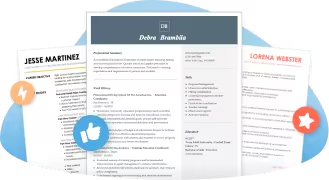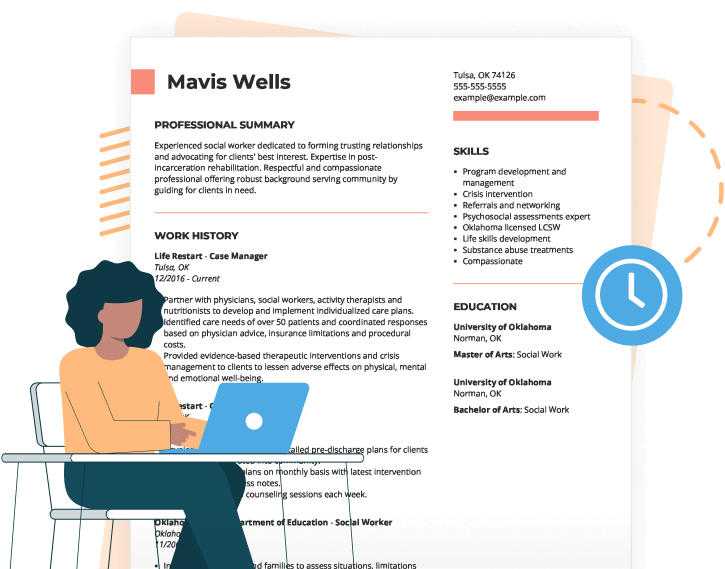Featured Resume Examples
More top-requested arts resume examples are for Painter, Illustrator and 3D Artist. Looking for additional art roles? Scroll on, we have plenty more below.
Search Arts Jobs
Arts Resumes by Job Title
Find the resume example you need by browsing these specific Arts categories:
Digital Media Roles (7)
Fine Arts and Performance Roles (7)
Leadership and Senior Roles (6)
Supportive Roles (4)
Technical Roles (9)
Cover Letter Examples for Arts Jobs
Job Outlook
Art is far more than just painting. As you can see from the jobs listed above, there are wide-ranging job opportunities in the Arts industry.
According to the U.S. Bureau of Statistics, while the employment rate of fine artists will remain more or less the same until 2029, the demand for multimedia and digital artists is projected to grow 4%.
Whatever your niche, we want to help you land that job! First things first, let’s make sure your resume is extraordinary.
3 Tips for Writing Arts Resumes
Choose the Right Format for Your Arts Resume
A resume format is really just the way your resume is organized, and choosing the best fit for you comes down to your years of experience in the field and what you’re applying for.
If you’re a candidate with many years of consistent employment in the arts industry — say ten years or more — there are two routes for you:
- A CV if your career in arts gears more towards academics or you want to apply for grants, gallery shows, competitions, etc.
- Or the chronological resume
An artistic CV shows everything you’ve done and accomplished in your career. It includes samples of work, publications, awards, exhibitions, collections and memberships to arts-related organizations. It’s much more detailed and longer than a regular resume because it tells the story of your professional life. Usually the hiring manager will request that you send a CV instead of a resume.
The chronological resume is a lot shorter, no more than two pages, and it focuses on your career progression. It’s the best and most organized way to show the hiring manager, for example, how you went from being an art gallery assistant to a curator.
However, the chronological format might not be the best fit if you have little to no experience working in the arts. If you’re fresh out of art school or changing industries, check out the functional resume!
A functional resume puts greater emphasis on your skills and education. That way you can focus on your abilities and the things that you’re good at, instead of your scarce art experience.
If you have a couple of years of experience, but less than five in total, you might want to consider using the best of both worlds: the hybrid format.
It works just as it sounds. It’s a mix between a chronological and functional format that puts more emphasis on your skills. But it also gives more space to describe your arts history than a functional resume.
Our advice: Read the job application and choose one of these formats before you begin writing. It will help you make sure your information is presented in the strongest way given your experience.
Promote Sought-After Resume Skills
While each art form requires its own set of skills, certain skills are considered desirable and beneficial to possess for all artistic roles.
Make sure that you highlight some of these skills when applicable to your abilities so that employers know you’re what they’re looking for.
Some sought-after skills in the arts include:
- Critical thinking
- Attention to detail
- Creativity
- Innovative
- Time management
- Initiative
- Passion
- Self-motivated
- Communication
- Team player
- Organized
- Responsible
- Flexible
- Presentation skills
- Consistency
- Positive attitude
- Ability to work under pressure
Try to feature some of these skills that best describe your strengths as an artist.
Use a Template to Make Your Resume Look Eye-Grabbing
The fun thing about being an artist is that you get to create a resume that aligns with your creativity. Unlike many other careers, which are limited to traditional and conservative templates, artists can use templates with pictures, bold colors and cutting-edge designs.
Want a different color? You got it! Another font? No problem!
At JobHero, we have tons of examples and templates that will make it so much easier for you to have a resume that not only looks good but works to get you hired.
Consider using one of our many resume templates! It will help you organize your experience, skills and abilities, while still giving you the wiggle room to customize it the way you want.
Use our Resume Builder to your heart’s desire and get your resume ready in a few minutes. Once it’s done, you can save it and start sending hiring managers your masterpiece.
FAQ
How much do people in arts get paid?
It all comes down to the type of work you’re doing.
The U.S. Bureau of Labor Statistics estimates that the median annual wage of an artist is around $48,760, but growth in the industry will largely depend on whether people want to spend money on art.
For multimedia artists, like 3D Artists and Illustrators, the case is a little different given the ever-growing world of digital media. In May 2019, their annual wage was $72,270.
What qualifications do I need to work in the arts industry?
Each artistic role will require its own set of specific qualifications and skills.
A painter, for example, must possess knowledge of painting techniques, proper equipment, the different types of paints, and mixing colors.
Whereas an Illustrator would focus their resume on conceptualizing characters, assets or layouts, software knowledge, and even animation.
The best thing you can do is research the skills and qualifications needed for the role you want. It’ll help you understand what you can bring to the table!
Is a portfolio important to work in arts?
The short answer is a resounding yes!
The vast majority of roles in the arts industry require a portfolio. It’s a way for you to showcase your best work, skills and identity as an artist.
Most artists have online portfolios with examples of their work in the form of a webpage or professionally-dedicated social media page.
For your resume, you could either add the link underneath your email address in the contact section or create an online portfolio section that includes the link at the bottom of your resume.
What do careers in arts involve?
As you can see from the job titles above, the arts industry has many doors open for you. Each has its unique day-to-day tasks and responsibilities, but overall, working in arts involves creativity, the ability to meet deadlines, teamwork, and lots of passion.
Should I include a cover letter with my arts resume?
Definitely! Even if it’s not mentioned in the job posting, a cover letter will help you stand out to hiring managers in many ways.
Let’s start by saying that it’s a professional standard. If other candidates applying for the same job include a cover letter and you don’t, the chances of them getting called for an interview is higher.
A cover letter is a blank canvas that gives you the necessary space to further discuss your skills, work experience and achievements.
If works of art in museums have a label explaining the piece, why shouldn’t your resume?
To get started, check out some of the great examples from our library of arts cover letter samples.







